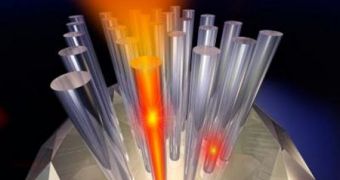Researchers at the Harvard University have recently finished developing a new type of diamond-based nanowire devices, which hold great promise for the creation of nanomaterials based on the strong carbon compound. These materials could, in turn, be used in quantum cryptography and computing, as well as imaging methods for magnetic fields. Further applications in quantum science and technology are also possible, the team reports.
One of the greatest innovations that the new system brings is the fact that secure, light-based computing could soon be made practical. Such communication networks would rely on the nanowire devices, which are capable of producing a bright, stable source of single photons at room temperature. Details of the achievement were published yesterday, in the February 14th issue of the respected scientific journal Nature Nanotechnology. The team was led by Harvard School of Engineering and Applied Sciences (SEAS) Assistant Professor of Electrical Engineering Marko Loncar.
“Our nanowire device can channel the photons that are emitted and direct them in a convenient way,” SEAS graduate student Tom Babinec, also the lead author of the journal entry, adds. “We consider this an important step and enabling technology towards more practical optical systems based on this exciting material platform. Starting with these synthetic, nanostructured diamond samples, we can start dreaming about the diamond-based devices and systems that could one day lead to applications in quantum science and technology as well as in sensing and imaging,” Loncar believes.
The devices themselves were all constructed at the Harvard Center for Nanoscale Systems (CNS), with funding secured under the US National Science Foundation's (NSF) Nanoscale Interdisciplinary Research Team (NIRT) grant. The Defense Advanced Research Projects Agency (DARPA) also contributed to the investigation. Further advancements in this technology could see it employed inside new generations of chemical and biological sensors, as well as in a wider variety of scientific imaging methods.

 14 DAY TRIAL //
14 DAY TRIAL //